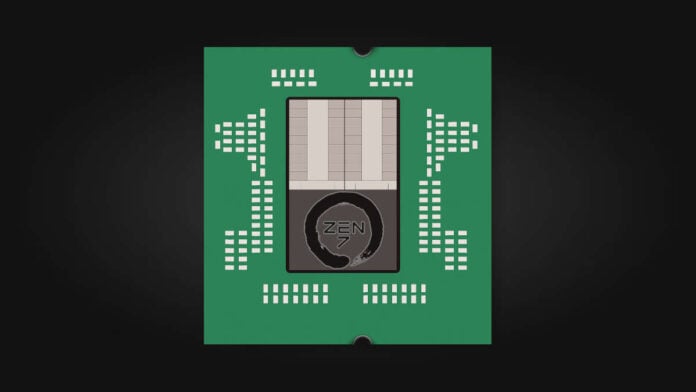Next-gen AMD Ryzen CPUs come equipped with up to 32 cores, thanks to a new CCD design, as well as a huge amount of cache. Leaker Moore’s Law Is Dead (MLID) has shared all he knows about the new AMD Zen 7 processors in a new YouTube video. On the menu are two CCD designs, one with eight cores and the other with 16 cores, alongside plenty of cache before you even add 3D V-Cache to the equation. The general performance uplift also looks set to be solid, pushing overall performance miles away from Zen 5.
MLID claims to have gathered this information from a multitude of sources working directly at AMD and close partners. They indicate that AMD is planning to use CCDs with up to 16 cores in its high-end Zen 7 CPUs, but with 8-core CCDs on the lower ranges. These Zen 7 classic cores – codenamed Prometheus – will reportedly be available on desktop, laptop, and Epyc CPUs. According to MLID, they will be manufactured using TSMC’s A14 node, with each core each packing 2MB of L2 cache plus 8MB of L3 cache. The I/O die on the other hand will reportedly be made using TSMC’s 6nm process.
If that’s the case, each CCD will contain 32MB of L2 and 64MB of L3 on-die cache, on top of which the company can add another 160MB of L3 for a total of up to 224MB of L3 per CCD, or 448MB per CPU. Understandably, to fit all these cores and cache inside one chiplet, Zen 7 CCds will need to be physically huge, with MLID saying they measure 98mm². Due to the higher silicon area requirements, not to mention the higher cost of TSMC’s leading-edge manufacturing, the 16-core CCDs are said to be exclusive to the high-end models. As a result, it wouldn’t be surprising to see the 32-core Ryzen chip being priced at $999.
Meanwhile, the smaller 8-core Zen 7 chiplets are said to measure 56mm², packing the same amount of on-die cache as the 16-core CCD variants but without support for 3D V-Cache. If that’s correct, it could potentially mean the end of ‘budget’ X3D chips like the Ryzen 5 7600X3D.
In terms of performance, MLID estimates that Zen 7 will offer a boost in the instructions per clock (IPC) of 15-25% in single-threaded apps, and 50-67% in multi-threaded software compared to Zen 6 CPUs. The latter is thanks to the 33% increase in core count, with MLID’s sources claiming that 8% of this performance comes from the new cache design alone. Compared to Zen 5, Zen 7 could be over 50% and 150% faster in single and multi-threaded workloads, respectively.
MLID also mentioned Zen 7 “Steamboat”, a massive Epyc CPU configuration boasting 264 cores (8×33) and up to a mind-boggling 2,122MB of L3 cache using a new V-Cache stacking technique. For comparison, AMD’s Genoa‑X Epyc 9004 series maxes out at 1,152MB on the Epyc 9684X. Unfortunately, the previously rumoured dual-stacked V-Cache apparently isn’t on the menu with Zen 7, and MLID’s sources hint at its absence from Zen 6 too.
Lastly, on the APU side, Zen 7 is expected to offer up to 12 cores, comprising four classic and eight dense cores, with the possibility to add another eight through a secondary chiplet for a total of 20 cores. And this without factoring in any LP (low power) cores that may be added.
According to MLID, Epyc Zen 7 could launch in the first half of 2028, with desktops and laptops likely following before the end of the year. Now, considering that Zen 6 may slip to Q1 2027, this seems like an aggressive release cadence that may end up being slightly adjusted.
To be informed in case this happens, make sure to follow the Club386 Google News.

